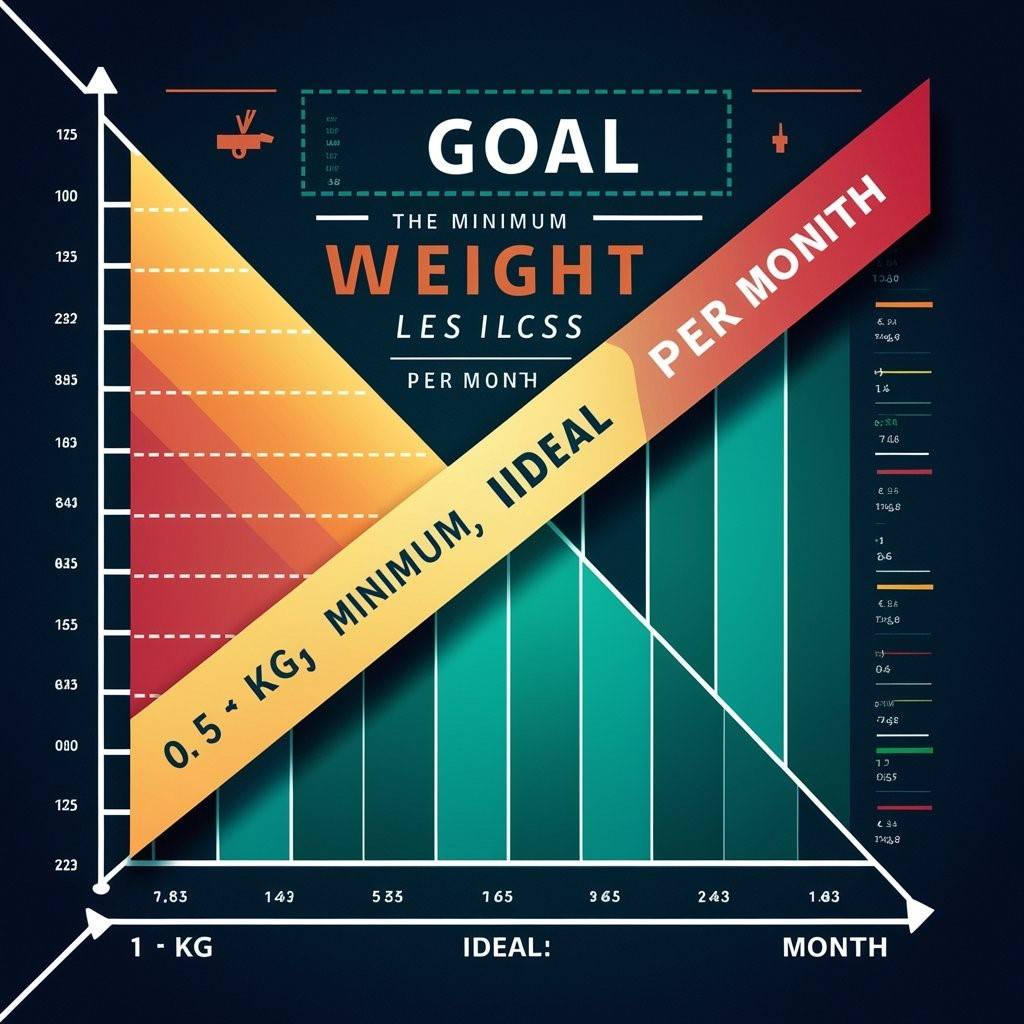What is Healthy Weight Loss Per Month: The Surprising Truth
Discover the surprising truth about what is healthy weight loss per month. Get science-backed tips for safe, sustainable weight loss without extreme measures.
Key Takeaways: What is Healthy Weight Loss Per Month

| Goal | Healthy Weight Loss Per Month |
| Minimum | 0.5 – 1 kg (1 – 2 lbs) |
| Ideal | 1 – 2 kg (2 – 4 lbs) |
| Maximum | 2 – 3 kg (4 – 6 lbs) |
Introduction
Losing weight can be a challenging and frustrating experience, but understanding what is healthy weight loss per month is crucial to achieving your goals safely and sustainably. Many people set unrealistic expectations, leading to disappointment, potential health risks and eventual weight regain. In this comprehensive guide, we’ll explore the surprising truth about healthy weight loss per month, debunk myths, and provide you with science-backed strategies to reach your ideal weight healthily.
Understand the Basics of Weight Loss
Before diving into the specifics of what is healthy weight loss per month, it’s essential to comprehend the fundamentals of weight loss. The simple equation is burning more calories than you consume leads to weight loss. However, this process is influenced by various factors, including your metabolic rate, lifestyle, and genetics.
To lose weight healthily, you need to create a calorie deficit by reducing your caloric intake increasing your physical activity levels, or a combination of both. It’s generally recommended to aim for a calorie deficit of 500 to 1,000 calories per day, which should result in a healthy weight loss of 0.5 to 1 kilogram (1 to 2 pounds) per week or 2 to 4 kilograms (4 to 8 pounds) per month.
The Surprising Truth About What is Healthy Weight Loss Per Month
While the general guideline of 0.5 to 1 kilogram (1 to 2 pounds) per week or 2 to 4 kilograms (4 to 8 pounds) per month is a good starting point, the truth is that healthy weight loss per month can vary significantly from person to person. Several factors influence the rate of weight loss, including:
- Starting Weight: Generally, individuals with a higher body weight tend to lose more weight initially due to a higher calorie expenditure.
- Age and Gender: Metabolic rates tend to decrease with age, and men typically have a higher metabolic rate than women.
- Genetics: Some people may have a genetic predisposition that makes weight loss easier or more challenging.
- Lifestyle Factors: Your physical activity levels, sleep patterns, and stress management can impact weight loss.
- Medical Conditions: Certain medical conditions, such as hypothyroidism or polycystic ovary syndrome (PCOS), can make weight loss more difficult.
Despite these variations, it’s generally accepted that a healthy weight loss per month should fall within the range of 2 to 6 kilograms (4 to 12 pounds). What is healthy weight loss per month? It is generally between 2 to 6 kilograms (4 to 12 pounds). Losing more than this amount may be challenging to sustain and could potentially lead to negative health consequences.
The Dangers of Rapid Weight Loss
While the temptation to lose weight quickly can be strong, rapid weight loss (more than 2 to 3 kilograms or 4 to 6 pounds per month) can have serious health consequences. Here are some potential risks associated with losing weight too quickly:
- Nutrient Deficiencies: Extreme calorie restriction can lead to deficiencies in essential nutrients, such as vitamins, minerals, and protein, which can negatively impact your overall health.
- Muscle Loss: When you lose weight too quickly, your body may burn muscle tissue for energy, which can slow down your metabolism and make it harder to maintain your weight loss in the long run.
- Gallstones: Rapid weight loss can increase the risk of developing gallstones, which can be painful and potentially require surgical removal.
- Fatigue and Weakness: Extreme calorie restriction can leave you feeling tired, weak, and unable to perform daily activities effectively.
- Hormonal Imbalances: Rapid weight loss can disrupt the balance of hormones in your body, leading to issues such as irregular menstrual cycles, decreased fertility, and metabolic problems.
- Hair Loss: Severe calorie restriction and nutrient deficiencies can cause hair thinning or excessive hair loss.
To avoid these risks, it’s essential to aim for a healthy weight loss of 0.5 to 1 kilogram (1 to 2 pounds) per week or 2 to 4 kilograms (4 to 8 pounds) per month.
Factors that Influence What is Healthy Weight Loss Per Month
Several factors can influence what is healthy weight loss per month for an individual. Understanding these factors can help you set realistic expectations and achieve your weight loss goals safely and sustainably.
- Starting Weight
Your starting weight plays a significant role in determining what is healthy weight loss per month. Generally, individuals with a higher body weight tend to lose more weight initially due to a higher calorie expenditure.
For example, someone with a body mass index (BMI) of 30 or higher (considered obese) may lose more weight in the first few months compared to someone with a BMI within the normal range (18.5 to 24.9).
- Age and Gender
Age and gender can also influence what is healthy weight loss per month. As we age, our metabolic rates tend to decrease, making weight loss more challenging. Additionally, men generally have a higher metabolic rate than women, which can result in faster weight loss for men, even when following the same diet and exercise plan.
- Lifestyle Factors
Your lifestyle habits, including physical activity levels, sleep patterns, and stress management, can significantly impact what is healthy weight loss per month. Regular exercise and a good night’s sleep can boost your metabolism and support weight loss efforts, while chronic stress can lead to overeating and weight gain.
- Medical Conditions
Certain medical conditions, such as hypothyroidism, polycystic ovary syndrome (PCOS), or Cushing’s syndrome, can make weight loss more challenging. If you have a medical condition that may be affecting your weight, it’s essential to work closely with your healthcare provider to develop a personalized weight loss plan that addresses your specific needs.
- Genetics
Genetics can also play a role in what is healthy weight loss per month. Some individuals may have a genetic predisposition that makes weight loss easier or more challenging. However, it’s important to note that genetics are not a determinant of success or failure in weight loss; with the right strategies and perseverance, anyone can achieve their desired weight.
By understanding these factors, you can set more realistic expectations and adopt a personalized approach to healthy weight loss per month.
Tips for Achieving Healthy Weight Loss Per Month
While what is healthy weight loss per month may vary from person to person, several strategies can help you achieve your weight loss goals safely and sustainably:
- Create a Calorie Deficit: To lose weight, you need to create a calorie deficit by consuming fewer calories than your body burns. A deficit of 500 to 1,000 calories per day is generally recommended for healthy weight loss of 0.5 to 1 kilogram (1 to 2 pounds) per week.
- Focus on Sustainable Lifestyle Changes: Instead of following fad diets or extreme calorie restrictions, focus on making sustainable lifestyle changes, such as eating a balanced diet rich in whole foods and incorporating regular physical activity into your routine.
- Increase Protein Intake: Protein can help you feel fuller for longer and preserve muscle mass during weight loss. Aim to include lean protein sources, such as chicken, fish, eggs, and legumes, in your meals and snacks.
- Stay Hydrated: Drinking plenty of water can support weight loss by promoting feelings of fullness and boosting metabolism.
- Manage Stress Levels: Chronic stress can lead to overeating and weight gain. Practice stress management techniques, such as meditation, yoga, or deep breathing exercises, to help keep your stress levels under control.
- Get Enough Sleep: Adequate sleep is crucial for weight loss and overall health. Aim for 7-9 hours of quality sleep each night to support your metabolism and manage hunger hormones.
- Be Patient and Consistent: Weight loss is a journey, and it’s essential to be patient and consistent with your efforts. Remember that healthy weight loss per month may be gradual, but it’s a sustainable approach that can lead to long-term success.
- Track Your Progress: Regularly monitoring your weight, body measurements, and progress can help you stay motivated and adjust your plan as needed.
- Seek Support: Surround yourself with a supportive network of friends, and family, or join a weight loss support group. Having a solid support system can make a significant difference in your weight loss journey.
By following these tips and being mindful of individual factors that influence healthy weight loss per month, What is healthy weight loss per month? It is generally between 2 to 4 kilograms (4 to 8 pounds) per month. You can achieve your weight loss goals safely and sustainably, without compromising your overall health and well-being.
Lists: Examples of Healthy Weight Loss Strategies
Here are some examples of healthy weight loss strategies that can help you achieve a safe and sustainable weight loss per month:
- Meal Planning and Preparation:
- Plan your meals and snacks ahead of time.
- Prepare healthy meals in advance to avoid unhealthy choices.
- Include a variety of nutrient-dense foods, such as fruits, vegetables, lean proteins, and whole grains.
- Portion Control:
- Use smaller plates and bowls.
- Measure and weigh your portions.
- Practice mindful eating and pay attention to hunger and fullness cues.
- Increase Physical Activity:
- Engage in regular cardiovascular exercise (e.g., brisk walking, jogging, cycling)
- Incorporate strength training exercises to build and maintain muscle mass.
- Try high-intensity interval training (HIIT) for an efficient calorie burn.
- Stay Hydrated:
- Drink water throughout the day.
- Limit sugary beverages, such as sodas and juices.
- Choose unsweetened teas, coffee, or infused waters for added flavour.
- Get Enough Sleep:
- Aim for 7-9 hours of quality sleep each night.
- Establish a consistent sleep routine.
- Create a sleep-friendly environment (e.g., cool, dark, and quiet)
- Stress Management:
- Practice relaxation techniques, such as meditation, deep breathing, or yoga.
- Engage in enjoyable activities and hobbies to reduce stress.
- Seek support from friends, family, or a mental health professional if needed.
By incorporating these strategies into your daily routine, you can create a calorie deficit and promote healthy weight loss per month without compromising your overall health and well-being.
FAQs: What is Healthy Weight Loss Per Month
What is a healthy weight loss per month in kg?
A healthy weight loss per month typically ranges from 2 to 4 kilograms (4 to 8 pounds). Losing more than 4 to 6 kilograms (8 to 12 pounds) per month is generally not recommended, as it may lead to potential health risks.
What is a good weight loss for a month?
A good weight loss for a month is within the range of 2 to 4 kilograms (4 to 8 pounds). This rate of loss is generally considered safe and sustainable for most individuals.
Is it possible to lose 5kg in a month?
While some individuals can lose 5 kilograms (10 pounds) in a month, especially if they have a higher starting weight, this rate of loss may be challenging to sustain and could potentially lead to negative health consequences. It’s generally recommended to aim for a more moderate weight loss of 2 to 4 kilograms (4 to 8 pounds) per month.
What is a healthy weight loss limit per month?
Most experts agree that a healthy weight loss limit per month is typically around 4 to 6 kilograms (8 to 12 pounds). Losing more than this amount may be difficult to sustain and could potentially lead to various health risks, such as nutrient deficiencies, muscle loss, gallstones, fatigue, hormonal imbalances, and even hair loss.
Remember, weight loss is a journey, and it’s essential to adopt a balanced and sustainable approach that prioritizes your overall health and well-being. If you have any concerns or specific health conditions, it’s always best to consult with a healthcare professional or a qualified nutritionist for personalized guidance.
The Bottom Line on What is Healthy Weight Loss Per Month
Achieving healthy weight loss per month is a balanced and sustainable approach that prioritizes your overall well-being. By understanding the factors that influence weight loss, setting realistic expectations, and adopting sustainable lifestyle changes, you can achieve your desired weight safely and maintain it in the long run.
Remember, what is healthy weight loss per month can vary from person to person, but generally falls within the range of 2 to 4 kilograms (4 to 8 pounds). Losing weight too quickly can lead to various health risks and is often unsustainable.
To achieve healthy weight loss per month, focus on creating a moderate calorie deficit, increasing your protein intake, staying hydrated, managing stress levels, getting enough sleep, being patient and consistent, tracking your progress, and seeking support when needed.
By following these guidelines and prioritizing your overall health and well-being, you can embark on a successful weight loss journey and achieve your desired results without compromising your physical and mental well-being.
Read more about :
Unexpected14 Healthy Weight Loss Techniques: The Unexpected Strategies That Will Transform Your Body



